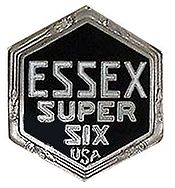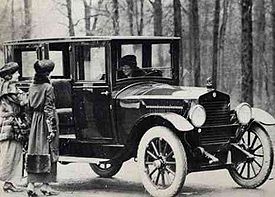
Essex (automobile)
Encyclopedia


Detroit, Michigan
Detroit is the major city among the primary cultural, financial, and transportation centers in the Metro Detroit area, a region of 5.2 million people. As the seat of Wayne County, the city of Detroit is the largest city in the U.S. state of Michigan and serves as a major port on the Detroit River...
between 1922 and 1932.
Corporate strategy
During its production run, the Essex was considered a small car and affordably priced. The Essex is generally credited with starting the trends away from open Touring carTouring car
A touring car, or tourer, is an open car seating five or more. Touring cars may have two or four doors. Often, the belt line is lowered in the front doors to give the car a more sportive character. They were often fitted with a folding roof and side curtains. Engines on early models were either in...
s toward enclosed passenger compartments as the rule, not the exception.
Originally, the Essex was to be a product of the "Essex Motor Company" which actually was a wholly owned entity of Hudson's. Essex Motors went to so far as to lease the Studebaker
Studebaker
Studebaker Corporation was a United States wagon and automobile manufacturer based in South Bend, Indiana. Founded in 1852 and incorporated in 1868 under the name of the Studebaker Brothers Manufacturing Company, the company was originally a producer of wagons for farmers, miners, and the...
auto factory in Detroit for production of the car. By 1922 the Essex Motor Company was dissolved and the Essex officially became what it was all along, a product of Hudson.
Essex cars
Essex cars were designed to be moderately priced cars which would be affordable to the average family. Proving durable, their capabilities were checked upon and confirmed by AAA and the United States Postal Service. In 1919 an Essex completed a 50-hour, 3,037.4 miles endurance test in Cincinnati, Ohio, at an average speed of 60.75 miles per hour. The early Essex cars also captured many hill climb records. In a special Essex race car, Glen Shultz won the 1923 Pikes Peak Hill Climb. It had a 108.5 inch wheelbase.Initially Essex marketed a line of touring cars (open four-door cars with canvas tops), which was the most popular body style of cars in production at the time. While Essex added an enclosed sedan in 1920, it was the introduction of the 1922 closed coach, priced at $1,495 (equal to $ today), only $300 (equal to $ today) above that of the touring car. By 1925 the coach was priced below that of the touring car. While Henry Ford is credited with inventing the affordable car, it was Essex that made the enclosed car affordable. In 1928, the big news was the use of four-wheel mechanical brakes.
Essex sales remained strong through the 1920s and into 1931 before sales began to trend downward. For 1932 a redesigned Essex debuted and was named the Essex-Terraplane, a play on the word aeroplane. By 1933 the Essex was no more and the car carried on as the Terraplane
Terraplane
The Terraplane was a car brand and model built by the Hudson Motor Car Company of Detroit, Michigan between 1932 and 1938. In its maiden year, the car was branded as the Essex-Terraplane; in 1934 the car became simply the Terraplane...
.
The instrument panel of the 1932 Essex featured the first use of "warning lights
Idiot light
A tell-tale is an indicator of the status or malfunction of a system within a motor vehicle. Tell-tales consist of a light bulb or an LED which lights up a symbol or text legend...
" instead of gauges.
Essex production models
- Essex CoachEssex CoachThe Essex Coach was manufactured by the Essex Motor Company in Detroit, Michigan.-Essex Coach specifications :* Color – Body and wheels, blue; running gear, black* Seating Capacity – Four or five* Wheelbase – 110½ inches...
An Essex motor car ( 4 door saloon ) was seen on the Aventine Hill in Rome outside of the church of Santa Sabina on 21 January 2010 being used in the filming of a period drama

